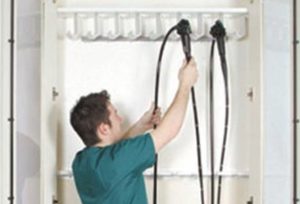 According to a recent study published in the American Journal of Infection Control, storing endoscopes in an automated cabinet with channel drying functionality effectively reduced bacterial growth in the scopes. Because endoscopes are reusable medical instruments, minimizing the amount of bacterial growth in the periods between procedures can dramatically improve patient safety.
According to a recent study published in the American Journal of Infection Control, storing endoscopes in an automated cabinet with channel drying functionality effectively reduced bacterial growth in the scopes. Because endoscopes are reusable medical instruments, minimizing the amount of bacterial growth in the periods between procedures can dramatically improve patient safety.
The study, performed by researchers at the David B. Geffen School of Medicine at UCLA and Northside Hospital in Atlanta, compared the drying effectiveness of automated cabinets with channel drying capability to standard endoscope storage cabinets. A recent article by Alex Young at Healio detailed the results:
“To test drying times, researchers took reprocessed bronchoscopes, colonoscopes and duodenoscopes and stored them in either an automated drying cabinet or a standard cabinet. They assessed dryness at 30 minutes, 1 hour, 2 hours, 3 hours and 24 hours using cobalt chloride paper.
After 24 hours in the standard cabinet, external surfaces were dry, but the internal channels still contained residual moisture. In the automated drying cabinets, external surfaces were dry at 3 hours and internal channels of the scopes were dry at 1 hour.
“Which makes sense,” [V. Raman Muthusamy, MD] said. “They’re hooked up, and air is getting blown directly through.”
To assess bacterial growth, researchers inoculated scopes after reprocessing with Pseudomonas aeruginosa and compared rates of microbial growth at 0, 3, 12, 24 and 48 hours.
In the standard cabinet, investigators found an average rate of colony forming unit growth of 8.1 × 106 per hour for bronchoscopes, 8.3 × 106 per hour for colonoscopes, and 7 × 107 per hour for duodenoscopes. In the automated drying cabinet, average colony forming unit growth rate was -28.4 per hour (P=.02), -38.5 per hour (P=.01), and -200.2 per hour (P=.02) in each type of scope, respectively.
“There was a pretty profound reduction in the bacterial growth rate when you used automated drying,” Muthusamy said. “The moisture definitely helps with bacterial growth. There will be some growth, but it’s quite low even at a period of several days compared to what you would see with no drying.”
Read the full article here: Automated endoscope drying cabinets reduce bacterial growth
As Dr. Muthusamy revealed through the study, automated endoscope drying cabinets significantly reduce the risk of passing deadly bacteria between patients by reducing dangerous moisture build-up to minimal amounts. One system that can bring these benefits to hospitals is iRIScope from Mobile Aspects, which was introduced in the last several years to guide healthcare providers through the proper, society-recommended HLD protocols every single time a scope is reprocessed. The system includes smart storage cabinets that allow scopes to hang vertically with forced air running through the channels. With iRIScope, sterile technicians will also be guided through the entire HLD process to make sure that any potentially harmful diseases are minimized via proper HLD techniques. Built-in technology will even alert your staff if improperly reprocessed scopes are hung in storage, or if it’s time to re-disinfect a scope based on hospital protocols.
